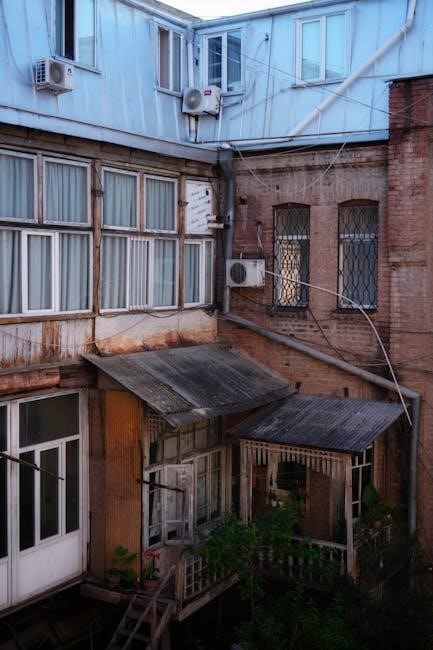Troubleshooting your Lennox air conditioner is essential for maintaining optimal performance and addressing common issues promptly. This guide provides practical steps to diagnose and resolve problems efficiently, ensuring your system runs smoothly and effectively, while also highlighting the importance of regular maintenance to prevent future malfunctions and extend the unit’s lifespan.
Importance of Regular Maintenance and Troubleshooting
Regular maintenance and troubleshooting are crucial for ensuring your Lennox air conditioner operates efficiently and effectively. Proper upkeep can prevent unexpected breakdowns, reduce repair costs, and extend the unit’s lifespan. Simple tasks like cleaning filters, inspecting coils, and checking thermostat settings can significantly improve performance. Addressing minor issues early helps avoid major repairs later, ensuring consistent cooling and energy savings. A well-maintained system also enhances indoor air quality and overall comfort, making it essential for homeowners to prioritize these practices.
Overview of Common Issues and Solutions
Lennox air conditioners often face issues like insufficient cooling, noisy operation, or failure to turn on. These problems can stem from dirty filters, refrigerant leaks, or faulty capacitors. Solutions include cleaning or replacing filters, checking thermostats, and ensuring proper airflow. Addressing these issues early can prevent costly repairs and maintain optimal performance. Regular checks and simple DIY fixes can resolve many problems, while more complex issues may require professional assistance to ensure the system runs efficiently and effectively.

Common Issues with Lennox Air Conditioners
Lennox air conditioners may experience issues like not blowing cold air, noisy operation, or failure to turn on. These problems often stem from dirty filters, refrigerant leaks, or faulty capacitors, requiring timely troubleshooting to restore functionality and efficiency.
AC Not Blowing Cold Air: Possible Causes and Solutions
If your Lennox AC isn’t blowing cold air, common causes include a dirty air filter, refrigerant leaks, or faulty thermostat settings. Check and clean the air filter, ensure the thermostat is set to cool mode, and verify refrigerant levels. Inspect condenser coils for dirt or blockages and ensure proper airflow through vents. Addressing these issues promptly can restore cooling efficiency and prevent further damage to the system.
Noisy Operation: Identifying and Addressing the Problem
Noisy operation in your Lennox AC can be caused by a faulty fan motor, blower issues, or a refrigerant leak. Inspect the fan for worn bearings, check for loose parts, and ensure the blower motor is balanced. A dirty air filter or clogged condenser coils can also lead to increased noise. Regularly cleaning the unit and tightening loose components can help mitigate these issues. If the problem persists, professional assistance may be necessary to diagnose and repair complex problems like capacitor malfunctions or internal mechanical faults.
AC Not Turning On: Potential Reasons and Fixes
If your Lennox AC isn’t turning on, check the circuit breaker or fuse box to ensure the power supply is intact. Verify the thermostat settings, ensuring it’s set to cool mode and the temperature is lower than the room. A faulty capacitor or broken contactor could also prevent start-up. Additionally, a tripped high-pressure switch or low refrigerant levels might be the cause. If these steps don’t resolve the issue, contact a professional to diagnose and repair complex electrical or refrigerant-related problems affecting the unit’s operation.
Insufficient Cooling: Troubleshooting Steps
If your Lennox AC isn’t cooling sufficiently, check for a dirty air filter, which can restrict airflow. Ensure all vents are unobstructed and free from blockages. Verify the thermostat settings to confirm the desired temperature is correctly set. Inspect the condenser coils for dirt or debris and clean them if necessary. Low refrigerant levels or a refrigerant leak could also cause insufficient cooling. If these steps don’t improve performance, consider professional inspection to address potential issues like compressor malfunction or improper system sizing.
Frequent Cycling: Causes and Solutions
Frequent cycling in your Lennox AC can be caused by a malfunctioning thermostat, improper system sizing, or low refrigerant levels. Dirty air filters or clogged vents may also contribute, restricting airflow and forcing the unit to work harder. Check the thermostat settings and ensure it’s calibrated correctly. Clean or replace the air filter and inspect vents for obstructions. If issues persist, a professional should evaluate the system for potential repairs, such as refrigerant recharge or thermostat replacement, to restore normal operation and efficiency.

Step-by-Step Troubleshooting Guide
Start by checking the thermostat settings and ensuring it’s in cool mode. Inspect and clean the air filter, then verify proper airflow through vents for optimal performance.
Checking the Thermostat Settings
Begin by ensuring the thermostat is set to “Cool” mode and the desired temperature is lower than the current room temperature. Verify that the thermostat is functioning correctly and not in “Heat” or “Off” mode. If your thermostat has a programmable feature, check the schedule to ensure it’s aligned with your cooling needs. A malfunctioning or incorrectly set thermostat can prevent your Lennox AC from turning on or cooling effectively, so this is always the first step in troubleshooting.
Inspecting and Cleaning the Air Filter
A dirty or clogged air filter is a common cause of Lennox AC issues. Locate the air filter, usually found in the return duct or near the furnace. Turn off the power to the unit before removing the filter. Inspect it for dust, dirt, or debris. Clean or replace the filter as needed, ensuring proper airflow. A dirty filter can restrict airflow, reduce efficiency, and cause the system to work harder, leading to potential malfunctions. Regular cleaning helps maintain optimal performance and energy efficiency.
Ensuring Proper Airflow Through Vents
Proper airflow through vents is crucial for your Lennox AC’s efficiency. Check all vents to ensure they are open and unobstructed. Furniture, curtains, or debris can block airflow, reducing performance. Close unused vents to direct air to needed areas. Clean vents regularly to remove dust and dirt. If vents are damaged or leaking, seal them to maintain optimal airflow. Restricted airflow can cause uneven cooling, increased energy bills, and system strain. Ensuring vents are clear helps maintain consistent cooling and system longevity.
Verifying the Power Supply
Ensure your Lennox AC has a stable power supply by checking the circuit breaker or fuse box. A tripped breaker or blown fuse can prevent the unit from operating. Verify that all switches, including the outdoor unit’s disconnect switch, are in the “on” position. If the issue persists, inspect the electrical connections for damage or wear. Consult a licensed electrician if you suspect a power supply problem, as improper electrical issues can lead to safety hazards or further system damage.
Advanced Troubleshooting Techniques
Advanced techniques involve analyzing error codes, inspecting for refrigerant leaks, and diagnosing capacitor or sensor malfunctions. These methods require specialized tools and expertise for accurate issue resolution.
Understanding Error Codes and Fault Conditions
Lennox air conditioners display error codes to help identify specific issues. These codes indicate problems such as sensor malfunctions, refrigerant leaks, or capacitor failures. By referencing the user manual or online resources, homeowners can decode these errors and diagnose the root cause. Common issues include faulty thermistors, low refrigerant levels, or communication errors between system components. Understanding these codes enables targeted repairs, reducing downtime and ensuring efficient operation. Regular checks can prevent minor faults from escalating into major breakdowns.
Identifying Refrigerant Leaks and Their Solutions
Refrigerant leaks are a common issue in Lennox air conditioners, often causing reduced cooling performance. Signs include hissing sounds, ice buildup on coils, or bubbling in the refrigerant lines. To identify leaks, inspect connections, hoses, and coils for damage or corrosion. Solutions involve sealing minor leaks or replacing damaged components. Professional technicians should handle refrigerant recharge and repair to ensure safety and compliance with regulations, as improper handling can lead to further damage or environmental hazards.
Diagnosing Capacitor Issues
Capacitor issues are common in Lennox air conditioners, often causing the unit to fail to start or run properly. Symptoms include the AC not turning on, a humming noise, or the fan not spinning. Capacitors can fail due to wear and tear, power fluctuations, or aging. To diagnose, check for visible damage, swelling, or leaking. Testing with a multimeter can confirm if the capacitor is faulty. Replacement typically requires a professional HVAC technician, as it involves complex electrical work and safety precautions.

DIY Repairs and Maintenance
Performing routine DIY maintenance, such as cleaning condenser and evaporator coils, replacing air filters, and inspecting thermostat settings, can significantly improve your Lennox AC’s efficiency and performance.
Cleaning the Condenser and Evaporator Coils
Cleaning the condenser and evaporator coils is crucial for maintaining your Lennox AC’s efficiency. Dirty coils can restrict airflow and reduce cooling performance. To clean them, turn off the power, gently remove debris with a soft brush or hose, and ensure proper drying. Regular cleaning prevents dust buildup and ensures optimal heat transfer. This simple DIY task can significantly improve your air conditioner’s performance and energy efficiency, while also extending the lifespan of the unit.
Replacing the Air Filter
Replacing the air filter in your Lennox air conditioner is a simple yet vital maintenance task. A dirty filter can restrict airflow, reduce efficiency, and increase energy costs. To replace it, turn off the unit, locate the filter, and remove it. Install a new filter with the correct MERV rating, ensuring it fits securely. Regular replacements every 1-3 months improve indoor air quality, prevent system strain, and maintain optimal cooling performance, keeping your home comfortable and your AC running smoothly.

Preventive Maintenance Tips
Regular checks on filters, coils, and vents ensure optimal performance. Schedule professional tune-ups annually to prevent issues before they arise, extending your Lennox AC’s lifespan and efficiency.
Regular Checks to Avoid Common Issues
Performing routine inspections is crucial for maintaining your Lennox AC’s efficiency. Check the air filter monthly and replace it as needed to ensure proper airflow. Inspect the condenser and evaporator coils regularly, cleaning them if necessary to prevent dust buildup. Verify that all vents are unobstructed and that the thermostat is functioning correctly. Additionally, monitor the system for unusual noises or leaks, addressing them promptly to avoid more severe issues. Schedule professional maintenance annually for a thorough evaluation and tune-up, ensuring your unit operates at peak performance throughout the year.
Professional Maintenance Recommendations
Professional maintenance is essential for ensuring your Lennox air conditioner operates efficiently and effectively. Schedule annual inspections with a certified HVAC technician to identify potential issues before they escalate. They will inspect and clean components, check refrigerant levels, and ensure proper system performance. Additionally, professionals can address complex problems like refrigerant leaks or capacitor issues, which require specialized tools and expertise. Regular professional tune-ups can extend the lifespan of your unit and maintain optimal cooling performance year-round.
Replacing Worn-Out Parts
Replacing worn-out parts is crucial for maintaining your Lennox air conditioner’s performance and preventing further damage. Components like air filters, capacitors, and fan motors may need replacement over time. Regular inspections can help identify parts that are deteriorating. When replacing parts, ensure they are compatible with your Lennox model for optimal functionality. Addressing worn parts promptly can enhance efficiency, reduce energy costs, and extend the unit’s lifespan, ensuring reliable cooling throughout the seasons.
When to Call a Professional
Call a professional if your Lennox AC issues persist after basic troubleshooting or involve complex repairs, such as refrigerant leaks or capacitor replacements, to ensure safety and proper resolution.
Recognizing Signs That Require Expert Help
Recognizing when to seek professional help is crucial for resolving complex Lennox AC issues. Persistent problems like refrigerant leaks, unusual noises, or error codes indicate the need for expert assistance. Additionally, if your AC fails to turn on or blows warm air despite basic troubleshooting, it may signal internal component failures requiring specialized tools and knowledge. Ignoring these signs can lead to further damage, increasing repair costs and downtime. Always prioritize safety and efficiency by consulting a certified technician for such issues.
Complex Repairs Beyond DIY
Some Lennox AC repairs require professional expertise due to their complexity and potential safety risks. Issues like refrigerant leaks, capacitor replacements, or internal component failures demand specialized tools and knowledge. DIY attempts can lead to further damage or safety hazards, such as electrical shocks or gas leaks. These repairs are best left to certified technicians who can ensure proper fixes and maintain system integrity. Trying to address these issues yourself can void warranties and compromise performance, making professional intervention essential.
Regular checks, timely repairs, and professional assistance when needed ensure optimal performance and longevity of your Lennox air conditioner, keeping your home comfortable and energy-efficient year-round.
Start by checking the thermostat settings, ensuring it’s in cool mode and set correctly. Inspect and clean the air filter, and verify proper airflow through vents. Check the power supply and circuit breakers to ensure the unit has power. Examine the condenser and evaporator coils for dirt or damage. Address issues like refrigerant leaks or faulty capacitors promptly. If problems persist, consult a professional to diagnose and repair complex issues, ensuring your Lennox AC operates efficiently and effectively.
Final Tips for Optimal AC Performance
Regularly replace air filters and clean condenser coils to ensure efficient cooling. Schedule annual professional tune-ups to identify potential issues early. Maintain proper thermostat settings and consider upgrading to a programmable or smart thermostat. Ensure all vents are unobstructed and doors/windows are sealed tightly. Address refrigerant leaks promptly and keep the outdoor unit free from debris. By following these tips, you can enhance your Lennox AC’s performance, reduce energy costs, and extend its lifespan significantly.
